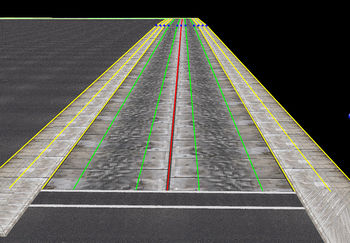BAI
Introduction
Each city may have one BAI-file. This file defines paths for controlling ambients such as pedestrians and automated traffic.
Format description
A BAI-file is built up in three sections. One section describes the routes, or roads, that are available for pedestrians and ambient traffic. One section describes the blocks where roads intersect and where pedestrians and ambient traffic are presented with a choice to select which road to take next. The last part of the BAI-file controls what roads are active for computations of pedestrians and ambient traffic.
Roads
The first section defines all the routes that pedestrians and ambient traffic can travel along. The routes, or roads, are defined by listing the PSDL blocks they pass through as well as several control curves defining lanes for pedestrians, cars, trams and trains.
Intersections
After the routes, all intersections are defined. This is done by informing MM2 of what PSDL block the intersection is located on and what roads are connected to this intersection.
Culling
The last part of the BAI-file lists the roads to compute ambients for depending on the given PSDL block id. This section is divided into two parts, one for large AI-bubbles and one for small. Each part gives one list of road indices that are to be active for each block of the PSDL. Active means that AI computations are performed for the roads listed for the block that the player is currently on. The first list in each part should be ignored and thus set to a length of zero.
Structure
In a pseudo-C style structure, a BAI-file looks like this:
struct BAI
{
char[4] header = "CAI1";
unsigned short nIntersections; // Number of intersections
unsigned short nRoads; // Number of roads
Road roads[nRoads]; // Roads
Intersection intersections[nIntersections]; // Intersections
Culling culling; // AI culling ("bubbles")
};
struct Road
{
unsigned short id;
unsigned short nSections; // Number of vertex sets
unsigned short unknown0; // No idea
unsigned short nBlocks; // Number of block references
unsigned short blocks[nBlocks]; // References to the PSDL
float unknown1; // Not sure. Speed threshold?
float unknown2; // Always == 15
RoadData right; // Data for right side
RoadData left; // Data for left side
float distance[nSections]; // Distances between centre points of the road
Vertex origin[nSections]; // Coordsys for tangent, origin
Vector xOrientation[nSections]; // Coordsys for tangent, X axis
Vector yOrientation[nSections]; // Coordsys for tangent, Y axis
Vector zOrientation[nSections]; // Coordsys for tangent, Z axis
Vector tangent[nSections]; // Direction of the road at each cross-section
RoadEnd end; // End of the road
RoadEnd start; // Start of the road
};
struct Intersection
{
unsigned short id;
unsigned short block; // Reference to the PSDL, (index + 1)
Vertex center; // Center point of intersection
unsigned short nRoads; // Number of connected roads
unsigned long roads[nRoads]; // Counterclockwise ordered references to roads connected to this intersection
};
struct Culling
{
unsigned long nBlocks; // Number of blocks in the PSDL + 1
CullingList cull0[nBlocks]; // Large AI bubbles
CullingList cull1[nBlocks]; // Small AI bubbles
};
struct CullingList
{
unsigned short nRoads;
unsigned short roads[nRoads]; // References to roads
}
struct RoadData
{
unsigned short nLanes; // Number of lanes
unsigned short nTrams; // Number of tram rails (bool?)
unsigned short nTrains; // Number of train rails (bool?)
unsigned short unknown3; // Sidewalk? Always == 1 (bool?)
unsigned short unknown4; // Type of ambients allowed on this side of the road (see below)
float lanesDistances[nLanes][nSections]; // Distances for right lanes
float distance[nSections]; // Outer edge distance
float Unknown[11 + nLanes]; // Something about the lanes, gladly padded with 0xcdcdcdcd
Vertex lLanesVertices[nLanes][nSections]; // Vertices for driving lane splines
Vertex sidewalkCenter[nSections]; // Vertices for sidewalk central spline
Vertex tramVertices[nTrams][nSections]; // Vertices for tram rail splines
Vertex trainVertices[nTrains][nSections]; // Vertices for train rail splines
Vertex sidewalkInner[nSections]; // Vertices for sidewalk inner spline
Vertex sidewalkOuter[nSections]; // Vertices for sidewalk outer spline
};
struct RoadEnd
{
unsigned long intersectionID; // Reference to Intersection[].id
unsigned short unknown0; // Always 0xcdcd
unsigned long vehicleRule; // See below
unsigned long intersectionRoadIndex; // Index in the intersections road list or 0xcdcdcdcd
Vertex trafficLightOrigin; // Origin of traffic light
Vertex trafficLightAxis; // Orientation of traffic light
};
struct Vertex
{
float x;
float y;
float z;
}
struct Vector
{
float x;
float y;
float z;
}
Values for RoadData.unknown4:
- 0 - Vehicles and pedestrians
- 1 - Pedestrians only
- 2 - Vehicles only
- 3 - Nobody (disables all traffic)
Values for RoadEnd.vehicleRule:
- 0 - Stop sign. The vehicles will stop, longest waiting vehicle drives first.
- 1 - Traffic light. One road at a time. All roads connected to the same intersection must have this control type, if not, the vehicles will behave as if it was a stop sign and the traffic light will blink between green and yellow. Traffic lights will only show up if their coordinates are not (0, 0, 0).
- 2 - Always stop. The vehicles stop and never proceed.
- 3 - Never stop. The vehicles will drive straight through the intersection without even slowing down.

